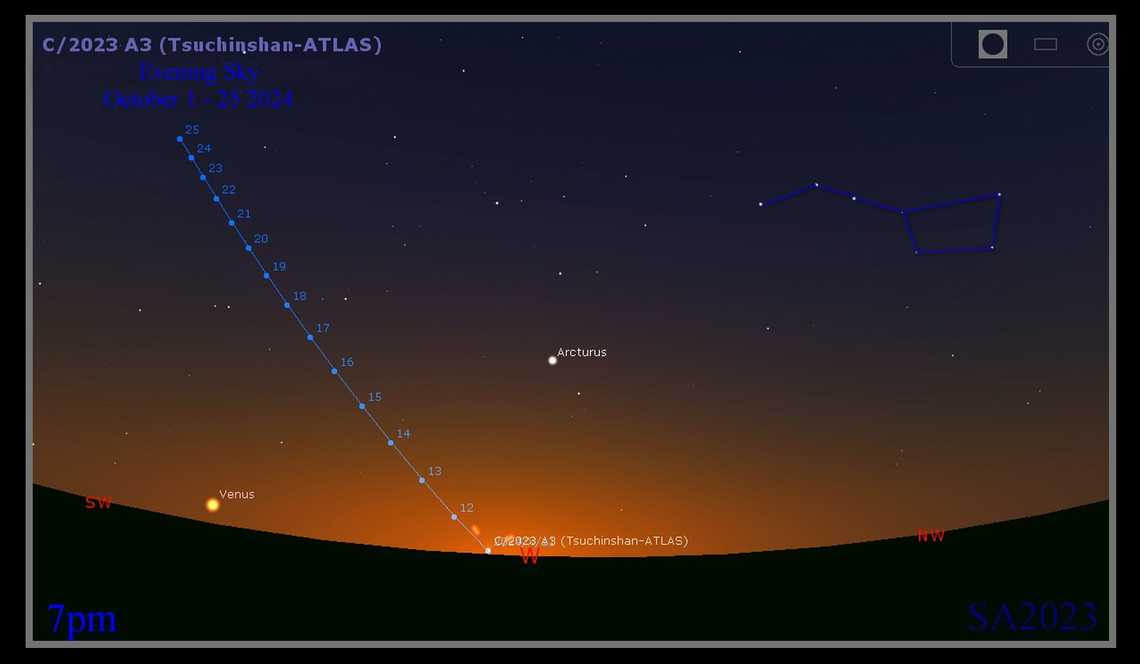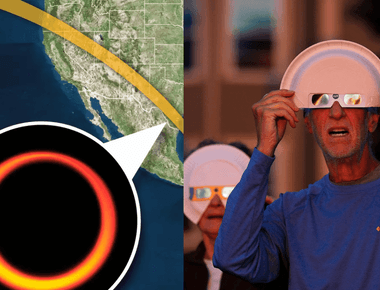
How to see October's 'comet of the decade' in before it disappears

This October, citizens of Earth have a rare opportunity to witness what could be the most dazzling comet of 2024, according to NASA. The comet will be visible before it travels to the farthest reaches of our solar system, where it won’t return for millennia.
Named C/2023 A3 Tsuchinshan–ATLAS, this comet is completing a lengthy 80,000-year orbit around the sun. Some are already calling it the “comet of the century” due to the brightness it may achieve. Throughout October, it will offer a spectacular sight before fading from view.
What is a Comet?
A comet is a small celestial body in the solar system, composed primarily of ice, dust, and rocky material. When a comet gets close to the Sun, it heats up, causing the ice to vaporize and release gas and dust. This process forms a glowing “coma” (the cloud surrounding the nucleus) and often results in a bright tail that extends away from the Sun due to solar radiation and wind.
Comets originate from two main regions in the outer solar system:
- The Kuiper Belt: A region beyond Neptune where short-period comets (with orbits of less than 200 years) are thought to come from.
- The Oort Cloud: A distant, spherical shell of icy bodies surrounding the solar system, home to long-period comets (with orbits of more than 200 years).
C/2023 A3 (Tsuchinshan–ATLAS) is originated from the Oort cloud, discovered by the Purple Mountain Observatory in China on January 9, 2023, and independently detected by ATLAS South Africa on February 22, 2023. The comet reached its perihelion on September 27, 2024, at a distance of 0.39 AU (58 million km; 36 million miles) from the sun, becoming visible to the naked eye.
How rare is a naked Eye Comet?
Naked-eye comets are relatively uncommon celestial events. On average, a naked-eye comet appears about once every 5-10 years. This frequency can vary significantly. Some years may see multiple naked-eye comets, while other periods might go by without any.
There are comets known as “great comets,” which are exceptionally bright and visible to the naked eye. On average, these comets appear once every 20 to 30 years. Famous examples include Halley’s Comet, last seen in 1986, and Hale-Bopp, which made its spectacular appearance in 1997.
When it comes to comets, their brightness is notoriously difficult to predict, unlike most other celestial events. While astronomers can estimate a comet’s potential brightness based on its size, trajectory, and proximity to the Sun, the unpredictability largely stems from the comet’s inherent instability. Comets are prone to fragmentation or breakage as they approach the Sun, which can either increase their brightness dramatically or cause them to dim unexpectedly, making precise forecasts challenging.
Best way to observe a comet?
To find the best time and place to see a comet, check resources like the internet, astronomy magazines, sky reports, or astronomy apps. Once you’ve gathered the information, don’t forget to share it with friends and family!
When the time comes, head to a remote location and allow your eyes to adjust to the twilight or darkness for at least an hour. This process, known as dark adaptation, will make it easier to spot faint objects like comets and their tails.
Make sure you find a clear view of the horizon where the comet is predicted to appear. Avoid areas obstructed by buildings, trees, or hills. An open field or a rooftop will offer an ideal viewing spot.
To enhance your viewing experience, consider using binoculars or a telescope.

While some comets are bright enough to be seen with the naked eye, binoculars or a small telescope will provide a clearer, more detailed view of the comet’s nucleus and tail.
Remember to protect your eyes. If you’re observing a comet near the Sun, especially during daylight or around sunrise/sunset, take precautions to avoid direct exposure to sunlight, which can seriously damage your eyes.
Forcast for Comet Tsuchinshan–ATLAS
October 2-9: Comet Tsuchinshan–ATLAS will be too close to the sun to be visible to the naked eye. However, observers with telescopes can still catch a glimpse of it in the early morning, provided they take precautions to protect their vision from the sun’s UV light. Optimistic forecasts suggest the comet could reach a brightness of magnitude -5.0, potentially making it visible even during the day, close to the sun.
October 10-12: The comet will emerge in the evening sky for observers in the Northern Hemisphere, appearing low in the western sky in the constellation Virgo, shortly after sunset. Though the observation window is brief, the comet may still be visible to the naked eye. The best chance to see it will be around October 12, when it makes its closest approach to Earth.
October 13-14: Although the comet will begin to lose some of its brightness, it will be farther from the sun, making it easier to observe. It should still be visible to the naked eye in the evening, roughly an hour after sunset.
October 15-19: The comet may produce a rare phenomenon known as an anti-tail, a bright streak that appears to point toward the sun, opposite to the direction of its other tails.
October 20-31: As the comet continues its journey, it will be best viewed with binoculars or telescopes.


Share
Related Posts



